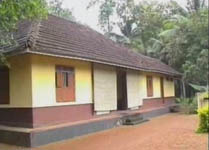
Early
Fr. Augustine, the Servant of God, whose parents were Itty Iype and Eliswa, was born on 1st April
1891, in Thevarparampil house, which was a branch of the ancient Kuzhumpil family. Among the five
children born to those parents, Augustine was the youngest.
On the seventh day the child was baptised in the parish church, Ramapuram.
It is the baptising
priest
who calls a baby by a name for the first time. This child was given the name Augustine, in
respectful
remembrance of the patron saint of the parish.
Prayerful Atmosphere in the Home
The influence exercised by the parents in giving a good character formation to the boy Augustine was great.
To the School
In those days pre primary schools such as kindergarten, nursery schools etc. were unheard of. Children in the villages were taught the alphabets and other initial matters by certain professional teachers, called Ashans, in their own schools, which were called Kalaris. The young boys and girls below five sat on the floor under a thatched roof. There were no pieces of furniture common to a class room, such as bench, desk etc. The Ashans were chiefly Hindus, and they treated all the children equally, irrespective of their religion.
In the Primary School
There was a primary school run by the Government of Travancore in the compound of Ramapuram Parish
Church. The building was constructed by the Church, and then handed over to the Government.
On completion of the course in the Kalari, Augustine joined the primary school. Wearing a small
cloth
around the waist and holding an umbrella made of palm leaf, the boy went to the school together with
his companions. He was the shortest one in his class.
At St. Ephrems School, Mannanam
After completing the primary classes at Ramapuram, K.M. Augustine joined St. Ephrem's High School at Mannanam and resided in the St. Alosyius Boarding attached to the school.
Perfect of Marian Sodality
In the boarding Augustine got the opportunity to foster the devotion to Mary, Mother of God, which he acquired from his parents.
Seminary
Augustine Thevarparampil joined the Minor Seminary at Changanacherry* to become a diocesan priest, like his uncles Frs. Joseph and Thomas. In the first decades of the 20th century motor vehicles were not seen on the roads of Kerala. People went from place to place, mostly on foot. Augustine's journey from Ramapuram to Changanacherry was accomplished in two phases. First he went to Kottayam on foot covering a distance of about 38 kilometers. He walked bare foot along the dusty roads full of stones and thorns. Then from Kottayam he travelled to Changanacherry by boat.
In the Major Seminary
On completing the minor seminary training, Bro. Augustine was admitted to the Puthenpally Seminary, at Varapuzha in June 1915.
Receives the Cassock
To receive the cassock, the official dress of a priest, was of special importance in the life of a cleric at that time. It was by this dress that a youngman was officially set apart from the other people. On July 16, 1915 Bro. Augustine Kuzhumpil received his cassock.
Ordination
At the end of the ninth year, his life in the Seminary reached its destination. On 21st December 1921 the Bishop raised him to the priesthood with power to celebrate the Holy Eucharist, preach the word of God, and administer the sacraments.
First Holy mass
Fr. Augustine celebrated his first Holy mass at Sr. Augustines Forane Church Ramapuram, with due solemnity. It was a great feast not only for the members of his family but to the parish community as a whole. As he was very small of stature, he came to be called Kunjachan (Little priest). The servant of God Kunjachan resided at Ramapuram, for a while, where he could get practical training under Fr. Kokkat.
Assistant at St. Sebastians Church, Kadanad
Fr. Augustine was appointed assistant Vicar at Kadanad Church, in February 1923. The vicar in that church was Fr. Thomas Kuzhumpil, a relative of the S. of God.
Blessing is Fruitful
Even while a young priest working as assistant, people used to approach him to save their crops from
damaging worms and insects. They believed sincerely that if he came to bless and sprinkle Holy
water,
the worms in the Ginger field and insects destroying the paddy perish and the crops would be
saved.
Mathai Sugusthy Nattunilathu from Ramapuram was a farmer, who had a fairly big plot with ginger
cultivation, at Manathoor. Once he found that some pernicious worms were destroying the crops and
they
were growing rapidly. Feeling very sad over the event, the farmer approached our young priest and
requested him to pay a visit to his ginger field. Kunjachan went with him immediately and on seeing
the destroyed ginger beds, asked him why he did not inform him earlier. Still he encouraged him and
asked him to rely on prayer. Then the priest went around the whole field, sprinkling Holy Water. He
spent about two hours there. Ever since that event there was no destruction from the worms, and the
farmer testified that he got an abundance of crops; more than what was expected.
Back to Ramapuram
Kunjachans service at Manathoor and Kadanad did not last long. As he got sick, he returned to
Ramapuram in March 1926.
It was while convalesceing at Ramapuram that he came across a new field of activity, hitherto
unattended by anyone else. He saw at Ramapuram and surrounding villages a class of people Harijans*
deprived of all social status ans who lived like slaves at the mercy of the landlords. On studying
the
sad elight of these poor people, he decided to dedicate himself to their evangelisation and
uplifting.
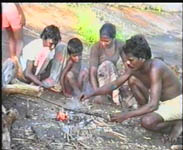
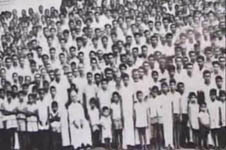
A Life of Service and Dedication
For centuries, Harijans (Dalits) at the Lowest Rung of the Social Ladder were treated as untouchables and even as unapproachables. The upper caste Hindus
kept them at a specified distance. If this was violated, they had to purify themselves by a
cleansing
bath. The low caste people were not even allowed to use the public roads, near temples. They were
never allowed to enter places of Hindu worship or schools or other public places.
Mar Thomas Kurialacherry, Bp. of Changanacherry was very kind to these hapless people and he
employed
every possible means to raise them up from their sad plight.
First of all he tried to convince the priests of the diocese about their obligation to sow the word
of
God among the poor. In a letter, the Bishop sent to the priests on 1st June 1916, we read: "The
great
desire of a good priest should not be acquiring higher positions or amassing abundance of wealth,
instead it should be the salvation of souls. To achieve this end, priests should follow the example
of
the Lord Jesus, discarding comforts, wealth and even the very life". The counsel of the Bishop
exerted
a deep influence on the mind of the young priest, Augustine.
Initiation in the Diocese
The Evangelical work in the diocese of Changanacherry was entrusted to Fr. Hilarios T.O.C.D., a
religious priest of the Syrian Carmelite congregation. Visiting the various parishes of the diocese,
he could attract many to the fold of the Holy Church, by his retreats and counsels. While residing
in
the monastery at Mutholy, he wrote to the parish priest of Ramapuram on 21-12-1924:
"I could find on special investigation in places like Piravom, Thuruthipally, Koothattukulam,
Ramapuram and Kudakachira, that there were many people ready to receive baptism. If the necessary
fund
is available, evangelisation work could be begun in those places, immediately ....................
Kindly inform me how you would be able to cooperate with me in this endeavour"
Annual Retreat and the first instance of Conversion
In his mission tour Fr. Hilarios T.O.C.D. came to St. Augustines Church, Ramapuram in March 1926.
Actually he had been invited by the then vicar, to preach the annual retreat to the community of the
faithful. At the insistance of the preacher, some of the landlords led their own dependents to the
Church on the last day of the retreat.
The preachers taught them the essentials of the Christian faith. With the intention of instructing
them further later on, they were ready to administer them the sacrament of Baptism. No one was
compelled to receive the sacrament. Those who were not interested could go home freely. It is
recorded
that about two hundred people received baptism on that day.
Opens a new Vista in Evangelisation
It was in March 1926 that Kunjachan God returned to Ramapuram from Kadanad. He noticed the events that happened in the Church during the annual retreat. There he witnessed the beginning of a new field of Evangelisation. He saw the hundreds of Harijan families, who lived around him. None of them owned even a single piece of land. They lived in small huts made in other peoples property. Not only were they illiterate, but they didnt even know the value of education. At the end of a days work, what they were given was only a small measure of rice. Reaching home in the evening they had to make use of this very rice to prepare food for themselves and their children. In the morning again they started to work in the field.
Instructors afraid to touch the students
In those days the children from Harijan families were denied admission in the public schools. Also the other students didnt like these poor children sitting beside them in the class. The teachers too hated their presence.
Shed as Schools
Kunjachan realised that there was not even a single person among the neophytes who knew to read and write. He was convinced that imparting education was of primary importance in the field of his activities. Therefore he started schools known as Kalaries in small sheds in different parts of the locality.
Day to Day Life
He rose at 4 a.m., prayed before the Blessed Sacrament, celebrated Mass, and with a catechist visited villages throughout the day, seeking out his flock—even on lands owned by non-Christians.
House Visits and Different Problems
Kunjachan visited the huts of each person, learned their names and conditions, and recorded family details carefully in an “Almasthithi Register”.
Priest Comes to Make Conversion
Alcoholism was common among the neophytes, even among women. He laboured to reform lives through instruction, prayer, and personal example.
A Share to the “Children”
Those who approached him hungry or thirsty always received a share of what he had.
Blouse for Women
To restore dignity, he arranged blouses for Harijan Christian women through Sr. Scholastica, using leftover cloth from cassocks.
Visited the Sick in Their Huts
The Servant of God was unafraid to visit the sick, even alone at night.
Prayer Is More Powerful Than Medicine
People esteemed his prayer and blessing as more effective than medicine, seeking his intercession in all needs.
Care of Domestic Animals
Without veterinary hospitals, many brought needs for cattle and sheep. After prayer and blessing, they testified to help received, regardless of religion.
Reservation at the Confessional
The Servant of God was always ready to hear confessions before or after Holy Mass.
The Meagre Food
In later years, when he became sick, he was admitted to Marygiri Hospital, Bharananganam.
A Circle and a Cross Inside
Convinced of cooperative power, he started a society with officers elected from among the neophytes.
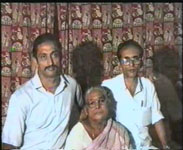
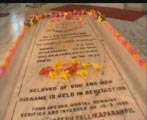
Last Days
Due to hard work and meagre food, he fell ill in 1959 and never fully regained health. When Kunjachan became more and more sick. As he had to depend on others for every personal need, and was advised to stay at his house for better treatment.
At Home
In the first few days after reaching home, he was found to be some what restless. Even when ill, he kept his morning meditation and prayers, listening to readings of the Gospel and lives of saints when he could not read himself. He was really sad at having left the premises of the Church, where he was staying for about half a century. On 17 Dec 1971 he completed 50 years of priesthood. Reluctant to celebrate, he finally consented to a modest observance, too weak to concelebrate, present in the sanctuary on a chair.
Yet, gradually he got himself accustomed to the new surroundings of the family. Many people,
including
his beloved fold, relatives and friends visited him regularly. Though in shortwords, he enquired
about
the whereabouts of each and every one of his flock.
The Last moments
Kunjachans health gradually deteriorated; respiration was difficult and he lay in bed always. The saintly priest suffered all his pain silently. He limited his speech to only a few words. On 16th Oct. 1973, two of his seminary mates, Fr. Sebastian Mattam, and Fr. Abraham Moongamackal reached Thevarparampil House quite accidentally, to visit their ailing old friend. Though he saw them standing beside the bed, he could not talk any thing distinctly. A sudden change was noticed in his facial expression. Understanding the gravity of the situation, the Reverend priests gave him the last blessing. The holy soul of Kunjachan flew into Heaven peacefully. Not long after, the bells of the parish church tolled announcing his death. People from all over parish and neighbouring places rushed to Thevarparampil House, to catch a last glimpse of the deceased Kunjachan.
To the Parish Church
On 17th morning, the dead body was taken to St. Augustines Church Ramapuram for the last services
and
burial.
On that very day itself many people approached the coffin imploring the intercession of the holy
priest who had just passed away. Some of them even touched their rosary, pen and other things on the
bier and prayed.
One more Mediator in Heaven
At the end of the concelebrated Mass in the afternoon, it was Fr. Valerian C.M.I., who spoke the
panegyric. He spoke well of Kunjachans holiness in life, apostolic zeal, kindness of heart, love for
the poor and other virtues. And towards the end he told quite enexpectedly, "we are participating in
the funeral of a saint. We have one more mediator in heaven".
Mar Joseph Pallikaparampil, the auxiliary bishop of Palai, officiated at the ceremonies, in the
absence of Bp. Mar Sebastian Vayalil, who was on a mission tour to the dioceses in Assam, Manipur
and
Nagaland.
Kunjachan was buried in a new tomb constructed in front of the altar of St. Augustine in the old
church, where he had been celebrating the Holy Mass for years. Eventhough he proposed in his will
that
he should be buried in the cemetry among the poor Harijan Christians, no one was willing to accede
to
that pious desire.
The unregistered will
The servent of God understood that he was approaching the end of his life. On a sheet of paper he wrote his last wishes. As he had nothing in his possession, there was no need of registering any will. In that document we read; "I do not possess anything either as land property or as cash account. Neither do I owe to anybody anything. The pieces of furniture in the room, belong to the senior priests of the Kolath family.
"After my death, the funeral must be conducted in the most simple way. Ever since 1926, I had been staying with the Harijan Christians. Even after death, I would like to be with them. Therefore my dead body should be buried, where the Harijan Christian are buried. The news of my death should not be published in newspapers. You need inform only the fellow priests of this parish, and the priests of the neighbouring parishes. The coffin should not cost more than twenty five rupees.
"I have to get Rs.464. Annas 6 and paise 3 from the Church, which amount I had spent as salary to the Catechist. To that amount, should be added Rs.35, Annas 9 and paise 9, which if I find difficult to realise, Ouseph Mathai, my eldest brothers son, should entrust to the Church, thus making the amount to be Rs.500/-. The interest of this amount should be spent to celebrate a Holy Mass and an office for the dead, on the day of my death anniversary.
"Dont celebrate the Sradham* with a ceremonial meal. Instead, it is enough that the prayers for the dead be done at the sepulchre. It is requested that on that occasion, the members of the family and the Harijan Christians make their confession, receive Holy communion and pray for the souls in Purgatory".
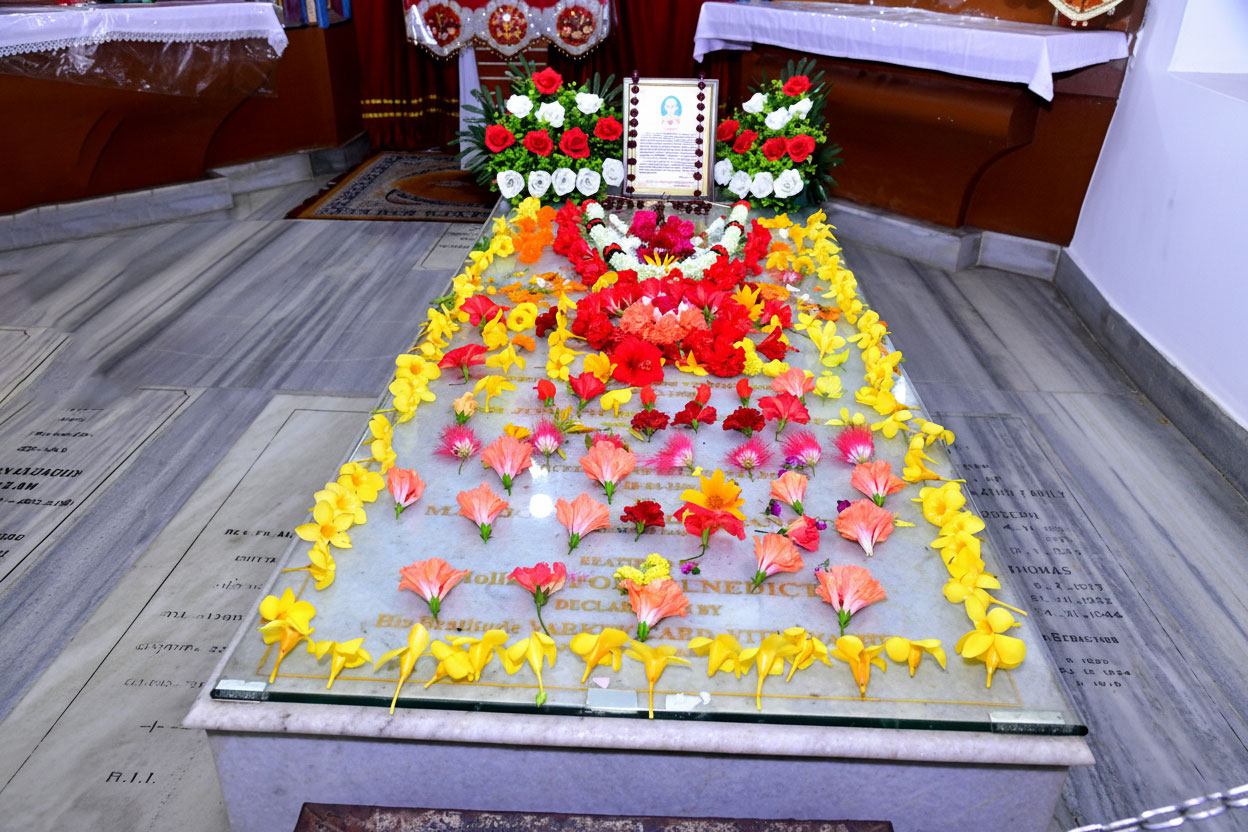
After Death
The day after the burial - People were convinced of the sanctity of the life of the Kunjachan even while he was alive. Such people were very sure that Kunjachan would be a powerful intercessor for them before the Almighty. So they began to come to his tomb to pray for his intercession. Protection of crops from destructive insects, curing of domestic animals, success in examinations, employment to the unemployed and similar items were the subjects of their prayer. As a memento of their gratitude, his photo was published in the daily newspapers. They felt that Kunjachan was still staying with them granting all kinds of wonderful favours.
Marble slab over the tomb
Some pilgrims who approached the tomb, knelt there and prayed for his intercession. While returning, they took home a little soil from that tomb. They experienced that, the soil had some miraculous power. When their number increased, it was necessitated that the sepulchre be kept safe, neat and tidy. Therefore the relatives of the Servant of God decided to instal a marble slab over the tomb. On 4th May 1974 Mar Sebastian Vayalil, Bishop of Palai blessed the slab and installed it.
Celebration of the Death Anniversary
From 16 Oct 1974 onward, death anniversaries drew thousands, turning Ramapuram into a pilgrim centre where bishops, priests, and people joined the memorial.
Initial Steps Towards Canonization
Public devotion spread widely. With “Nihil Obstat” granted, Fr. Antony Cairoli, OFM, was appointed Postulator; later succeeded by Fr. Giovanni Folguera, OFM.
Inauguration of the Diocesan Tribunal
On 11 Aug 1987, at St. Augustine’s Church, Ramapuram, the diocesan Tribunal was inaugurated in the presence of Card. Simon Lourdusamy. Oaths were taken, and the title “Servant of God” began to be used officially.
The Diocesan Tribunal in Sitting
From 15 June 1989, 129 witnesses were examined in 205 sessions; testimonies were translated to English and the final public session held on 6 June 1992. Documents were sealed and sent to Rome.
Historical Commission
Constituted on 6 June 1993, it researched widely; its report was sent to the Congregation of Saints on 15 Sept 1993.
Diocesan Process Approved
The Rome Congregation bound the acts in 36 volumes and approved their validity on 26 Nov 1993. Msgr. Jose Louis Gutiérrez was appointed Relator on 10 Dec 1993.
Centenary Celebrations of the Servant of God
On 1 April 1991, his 100th birth anniversary was marked with prayer, Holy Mass, and a public meeting; statewide competitions were held in his honour.
The Tomb Opened
Fearing damage over time and as part of the diocesan process, permission was granted to open the tomb on 10 March 1990. The mortal remains were reverently examined, preserved, and reinterred in a new sepulchre with proper seals and inscriptions.